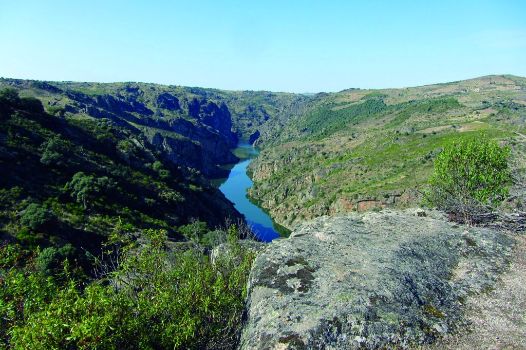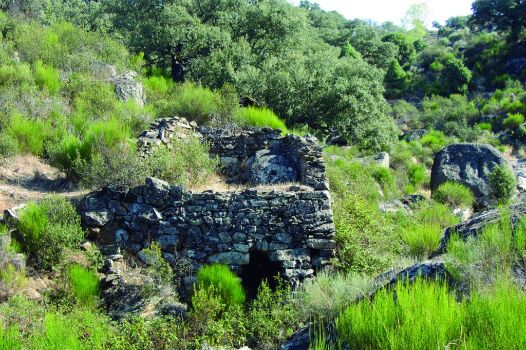Net of Natural
Trails

Stage 31: Pinilla de Fermoselle - Fermoselle
Description
Gazing over Arribes
After traversing through a path leading to an extraordinary balcony overlooking the cliffs of the River Duero, the route arrives at Fermoselle, the main town in Arribes del Duero in the province of Zamora. The peaceful walk is interrupted occasionally by the majestic flight of a vulture or Golden Eagle exploring its territory.
The route begins in the south edge of Pinilla de Fermoselle along a narrow path wedged between stone walls that lead to a small, seasonal creek. Shortly after, the path joins a wider path, known as Camino de los Arrieros.

After about 200 m, the path reaches a fork, where it continues left towards Pilos Creek. After crossing the creek, holm oaks (Quercus ilex) share the territory with junipers (Juniperus communis), Scotch brooms (Cytisus scoparius) and granite blocks, imparting the landscape a unique beauty.
The narrow path leads to a natural balcony with views of the spectacular meander on the River Duero.
These landscapes play host to a number of plant species, including the turpentine tree (Pistacia terebinthus), or "cornicabra". The plant gets its name in Spanish from the horn-shaped galls that occur on leaves bitten by insects. This species is found in rocky environments, interspersed amongst oaks and junipers. It has a hard, compact wood used in Arribes del Duero to make spoons, knife handles and castanets. A balm is made from the resin used for varnishes and as an antiparasite.
As the path continues down to Gorbias Creek, one can no longer see the River Duero. It now ventures into a site with a particular charm. The ruins of an old mill can be seen as one crosses the creek, with the grinding wheels on the upper storey.

As the Trail starts to regain altitude, one can enjoy again some panoramic views. The town of Pinilla de Fermoselle appears sometimes in the distance. The route crosses a rocky area where granite outcrops abound. Especially interesting are the eye-catching pieces of quartz and white rock, of which there are many.
The route ventures into an area affected by a forest fire, which has been colonised by brooms and rockrose (Cistus ladanifer).
From here, the path begins a steep descent to Rivera de Pinilla, towards a charming pontoon in a quiet place, undisturbed by human activity. The route climbs up a wider track towards a path that traverses through vast expanses of broom.
The landscape changes shortly before the Km 5 milestone, announcing the proximity of Fermoselle. The route ventures forth through vineyards, olive groves, and almond trees (Prunus dulcis) that grow on both sides of the path. One can glimpse the town of Fermoselle in the distance.
A spectacular fountain makes another roadside attraction before reaching the town. This fountain, Fuente de la Noria, collects the water that rises from the ground.
Sites of interest
Profile

Highlights
Further information
Granite
Granite is one of the most abundant rocks in County Arribes del Duero.
It is a volcanic or igneous rock, formed inside the Earth, through the cooling and slow crystallisation of magma. The resulting crystals are very well-formed and visible to the naked eye.
Granite contains three minerals: quartz, feldspar and mica. It is hard and highly resistant to weathering, and does not erode easily. The granitic landscape is very rugged, with an abundance of round rocks, known as "piedras caballeras" and huge slabs.
Nowadays, granite is a common building material in urban areas, a favourite of architects not only for its beautiful elegance, colours and durability, but also as a structural and decorative element.
Fermoselle
The town of Fermoselle, declared a Historical Artistic Site in 1974, is a maze of steep winding streets surrounded by old stone manors. Notable amongst its structures are the ruins of the Castle of Doña Urraca, on the edge of the town, and the church of Nuestra Señora de la Asunción, with its Romanesque walls and arches.
The town has seen an increase in activity in recent years due to the renovation of the Convent of San Francisco, where the Casa del Parque Natural Arribes del Duero is now housed.
The forest is burning
When one mentions forest fires, the first thing that comes to most people's minds is arson. However, natural forest fires are "inevitable" in Spain, owing to its high average temperatures throughout the year, in particular, very high temperatures and low rainfall in summer.
Indeed, nature has used fire to expand and regenerate for millions of years. There are many fire-resistant plant species, and some even need fire to reproduce.
Fire has been an evolutionary force that has shaped many ecosystems and spawned fire-adapted plants.
Some plants survive fire through high foliage water, and others by having thick, porous barks that isolate the living tissue from the fire. Trees and shrubs, such as holm oaks, junipers, broom and oaks, trigger shoots to sprout from the rootstock after a fire. Indeed, the new shoots are usually very vigorous due to the additional nutrients released by the ashes of the fire, and improved lighting conditions and water availability due to the elimination of other less fire-resistant plant species.




